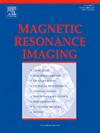应用缩小视场和低b值弥散加权成像检测腹主动脉瘤炎症。
IF 2.1
4区 医学
Q2 RADIOLOGY, NUCLEAR MEDICINE & MEDICAL IMAGING
引用次数: 0
摘要
目的:通过与延迟增强t1加权成像(DEI)比较,评价具有最佳b值和视场的弥散加权成像(DWI)对腹主动脉瘤(AAA)壁炎的鉴别价值。方法:前瞻性招募25名AAA男性患者,接受脂肪抑制t1加权黑血成像(T1WI)、全视场(f-FOV)和缩小视场(r-FOV) DWI (b值 = 0、100、400和800 s/mm2)和DEI。采用配对t检验和Wilcoxon符号秩检验对同一水平上f-FOV、r-FOV DWI和DEI对应图像进行定性和定量评价。采用加权kappa统计分析DWI和DEI序列在检测壁炎方面的一致性。结果:对于r-FOV和f-FOV DWI, DWI₁₀0 (Ps )的动脉瘤壁描绘和病变显著性评分最高,信噪比(SNR)和比噪比(CNR)最高。结论:r-FOV和低b值的DWI可以替代DEI识别AAA壁炎症。本文章由计算机程序翻译,如有差异,请以英文原文为准。
Detection of inflammation in abdominal aortic aneurysm with reduced field-of-view and low-b-value diffusion-weighted imaging
Objectives
To evaluate the performance of diffusion-weighted imaging (DWI) with an optimal b-value and field-of-view in identifying wall inflammation in abdominal aortic aneurysm (AAA) by comparing it to delayed enhancement T1-weighted imaging (DEI).
Methods
Twenty-five males with AAA were prospectively enrolled and underwent fat-suppressed T1-weighted dark-blood imaging (T1WI), full field-of-view (f-FOV) and reduced field-of-view (r-FOV) DWI (b values = 0, 100, 400 and 800 s/mm2), and DEI. Corresponding images on f-FOV, r-FOV DWI and DEI at the same level were evaluated qualitatively and quantitatively using the paired t-test and Wilcoxon signed-rank test. The agreement in detecting wall inflammation between DWI and DEI sequences was analyzed using weighted kappa statistics.
Results
For both r-FOV and f-FOV DWI, the scores of delineation of aneurysm wall and lesion conspicuity, signal-to-noise ratio (SNR) and contrast-to-noise ratio (CNR) were highest on DWI₁₀₀ (Ps < 0.05). The scores of delineation of aneurysm wall, geometric distortion, lesion conspicuity, and SNR, CNR were significantly higher on r-FOV DWI than those on f-FOV DWI (Ps < 0.05). r-FOV DWI₁₀₀ showed comparable performance to DEI in detecting wall inflammation (κ = 0.715), with superior blood suppression and higher SNR and CNR (Ps < 0.05).
Conclusions
DWI with r-FOV and low b-value could be a promising alternative to DEI in identifying wall inflammation in AAA.
求助全文
通过发布文献求助,成功后即可免费获取论文全文。
去求助
来源期刊

Magnetic resonance imaging
医学-核医学
CiteScore
4.70
自引率
4.00%
发文量
194
审稿时长
83 days
期刊介绍:
Magnetic Resonance Imaging (MRI) is the first international multidisciplinary journal encompassing physical, life, and clinical science investigations as they relate to the development and use of magnetic resonance imaging. MRI is dedicated to both basic research, technological innovation and applications, providing a single forum for communication among radiologists, physicists, chemists, biochemists, biologists, engineers, internists, pathologists, physiologists, computer scientists, and mathematicians.
 求助内容:
求助内容: 应助结果提醒方式:
应助结果提醒方式:


